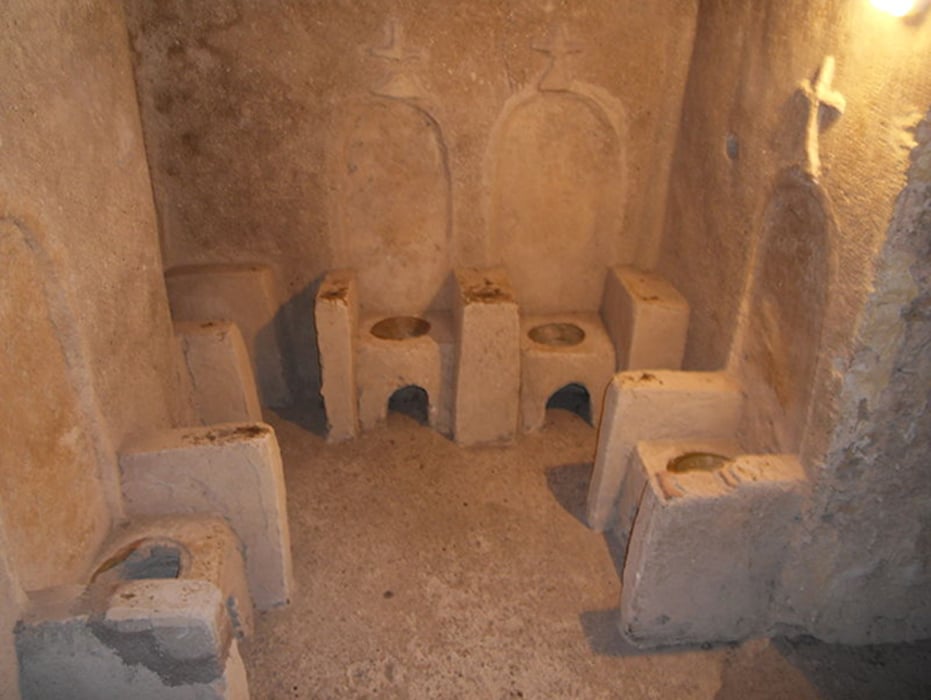Daily Prayers with Decomposing Corpses: Death Chairs at Aragonese Castle
The Aragonese Castle is a castle built on top of a rocky islet next to Ischia, a small Italian island on the northern end of the Gulf of Naples. Whilst a stronghold is said to have already been built during Classical times, much of the present structure dates to the Middle Ages. The Aragonese Castle has a history behind it, and arguably one of its most unique, not to mention macabre, is that of its ‘death chairs’, which belonged to the nuns of a convent that was established on the islet. These were stone chairs on which the bodies of deceased nuns were placed to decompose.
An Ancient Seat
It has been reported that the site where the Aragonese Castle now stands was already in use during the 5 th century BC. This was a time when parts of coastal southern Italy were extensively populated by Greek settlers. In 474 BC, the first fortification on the islet was built by Gerone I (also spelled as Hieron), a tyrant of Syracuse. In the following centuries, the islet was occupied by various peoples, including the Romans, Arabs, Normans, and Angevins. Each of them left their mark on the islet’s structures, though none more so than the Alfonso of Aragon, a king of Naples (as well as Aragon and Sicily).
- The eerie masks that preserve history and breathe life into the dead
- Bizarre Rituals of Blood and Death That Are Rooted in the Ancient World
- The Honorable Death: Samurai and Suicide in Feudal Japan

The island of Ischia’s Aragonese Castle. (CC BY-SA 3.0)
During the 15th century, the Kingdom of Naples was ruled by the House of Trastámara, a Spanish dynasty. This line of Neapolitan kings began with by Alfonso of Aragon, who had been the adopted heir of Joanna II, the Queen of Naples. When Joanna died in 1435, however, the throne passed to René of Anjou. As Alfonso was not satisfied with being disinherited, he launched a campaign against René, and succeeded in conquering the kingdom.
By this time, the Angevin castle had been abandoned, as Monte Epomeo, a volcano on Ischia, had erupted in 1301, and the islet’s inhabitants left their ruined homes for Ischia. It was Alfonso who decided to rebuild the Angevin castle, strengthening its fortifications, so that the inhabitants of the islet could find protection there against pirates, as well as enemies of the kingdom. It was also Alfonso who constructed the 220 m (720 ft) long stone bridge that connected the islet to Ischia.

‘Death chairs’ in Clarisse Cemetery, near Castello Aragonese (Ischia). (CC BY-SA 3.0)
Origins of the ‘Death Chairs’
It was only during the 16 th century that the ‘death chairs’ in the castle came into existence. Between 1575 and 1810, the Aragonese Castle was home to a community of nuns belonging to the Order of Saint Clare (known also as the Poor Clares). The nuns had a convent in the castle (which was called the ‘Convento delle Clarisse’) and practiced a rather unusual burial practice.
Whenever a nun died, her corpse would be taken to their cemetery, the ‘Cimitero delle Monache Clarisse’, and placed in a sitting position on a ‘death chair’. The corpses were left on these stone chairs to decompose.
This practice is not unique to this place, and other monks and nuns practiced the same ritual in the area which is known as a putridarium. Each ‘death chair’ has a hole on its seat, under which was placed a special vessel. These were meant to collect the fluids that were produced during the decomposition process. Once the bodies were completely decomposed, the remaining bones would be gathered, and place in an ossuary.
- Forgotten Rituals and Magical Practices in Ancient History
- Ritual Chambers of the Andes: Used in Secret, Near Death Simulations
- Mushroom Monuments of Thrace and Ancient Sacred Rites

The deceased nuns were left in seated positions to decompose. (CC BY 2.0)
Visiting the Dead
The nuns who were still alive would visit their dead sisters on a daily basis. Apart from praying for the dead, these visits were also meant to help the nuns meditate on their own mortality. Whilst this may have been a good form of spiritual exercise, it would almost certainly have been detrimental to their physical health. As they spent so much time in such an unhealthy place, the nuns often contracted serious illnesses.
In 1809, the Aragonese Castle was shelled by the British, as it was being held by the French. The damaged buildings were abandoned, and the convent was presumably one of them, as the Poor Clares left the castle in the following year. Whilst the convent is no longer home to a community of nuns, the ‘death chairs’ are a grim reminder of their presence in the Aragonese Castle, and may be seen today by tourists visiting the castle.
Top image: Stone seats at the putridarium in Clarisse Cemetery, near Castello Aragonese (Ischia). (CC BY-SA 3.0)
By Wu Mingren
References
Amy, 2017. The Creepy Cemetery on a Beautiful Italian Island. [Online]
Available at: https://boldtourist.com/the-creepy-cemetery-on-a-beautiful-italian-island/
Italy Heaven, 2018. Ischia Ponte. [Online]
Available at: http://www.italyheaven.co.uk/campania/ischia/ischiaponte.html
Lonely Planet, 2018. Castello Aragonese. [Online]
Available at: https://www.lonelyplanet.com/italy/attractions/castello-aragonese/a/poi-sig/1029510/1325026
StepYoshi, 2018. Poor Clares Convent Cemetery. [Online]
Available at: https://www.atlasobscura.com/places/poor-clares-cemetery
www.ischia.it, 2018. The Aragon Castle. [Online]
Available at: http://www.ischia.it/en/the-aragon-castle



















